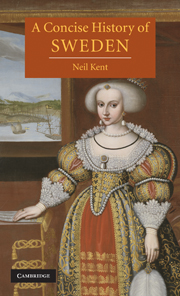Book contents
- Frontmatter
- Contents
- List of illustrations
- Maps
- Preface
- 1 From prehistory to Viking hegemony
- 2 The formation and growth of the Swedish state
- 3 The territorial consolidation of Sweden
- 4 Towards a centralist and military state
- 5 The collapse of absolutism and the Age of Freedom
- 6 Royal absolutism restored
- 7 Constitutional Sweden
- 8 The industrialisation and capitalisation of Sweden
- 9 The world wars and Swedish neutrality
- 10 Triumph of the Swedish welfare state
- Conclusion
- Appendix 1 Chronology
- Appendix 2 Monarchs and regents of Sweden
- Appendix 3 Prime ministers
- Selected further reading
- Index
8 - The industrialisation and capitalisation of Sweden
Published online by Cambridge University Press: 05 June 2014
- Frontmatter
- Contents
- List of illustrations
- Maps
- Preface
- 1 From prehistory to Viking hegemony
- 2 The formation and growth of the Swedish state
- 3 The territorial consolidation of Sweden
- 4 Towards a centralist and military state
- 5 The collapse of absolutism and the Age of Freedom
- 6 Royal absolutism restored
- 7 Constitutional Sweden
- 8 The industrialisation and capitalisation of Sweden
- 9 The world wars and Swedish neutrality
- 10 Triumph of the Swedish welfare state
- Conclusion
- Appendix 1 Chronology
- Appendix 2 Monarchs and regents of Sweden
- Appendix 3 Prime ministers
- Selected further reading
- Index
Summary
MILITARY PREPARATIONS
The middle years of the nineteenth century, a period in which the industrialisation and capitalisation of Sweden underwent a dramatic acceleration, occurred against a backdrop of pan-European military confrontation. Thus, the outbreak of the Crimean War in 1853, between Great Britain, France and the Ottoman Empire, on the one hand, and Russia on the other, was the first major test of Swedish neutrality. At first, Sweden declared itself neutral, but soon King Oskar I, with his advisers, began to see the possibility of a reacquisition of Finland in the event of an Allied victory. This was, in essence, an abrupt turning away from the ‘politics of 1812’, launched by his father, King Karl Johan, and Tsar Alexander I. Therefore, in 1855, Sweden confirmed the November Accord, with Britain and its allies, setting out Sweden’s willingness to resist Russia in return for Allied military support. Whether the unwillingness of some members of government to give their consent could have been overcome remains a moot point. In any case, the end of the Crimean War the following year changed the political scenario before Sweden was able to take part. As a result, in 1856 only the demilitarisation of the Finnish-owned Åland (Ahvenanmaa, in Finnish) Islands, already demanded by Britain, was laid down and confirmed by the Treaty of Paris. Sovereignty remained, however, with Finland, and therefore, indirectly, with Russia, popular support on the islands for Swedish rule notwithstanding. This ‘Åland Servitude’, as it was called, would remain a considerable source of disgruntlement for many years to come, in Sweden as well as on the Åland Islands.
- Type
- Chapter
- Information
- A Concise History of Sweden , pp. 172 - 215Publisher: Cambridge University PressPrint publication year: 2008



